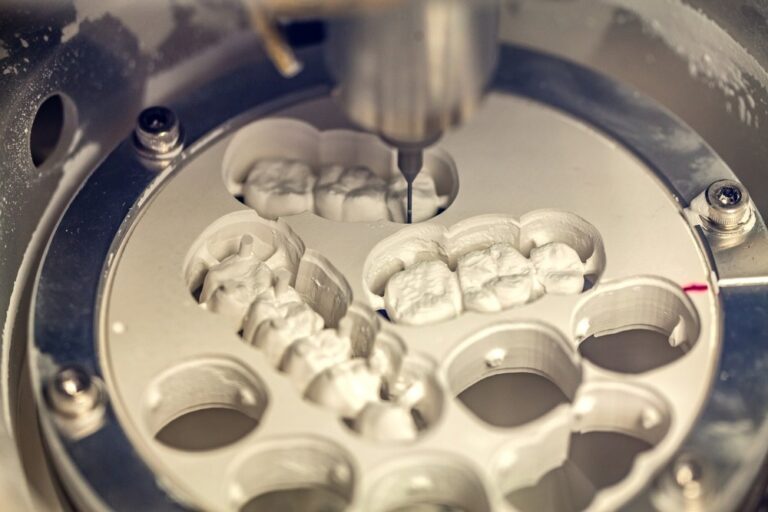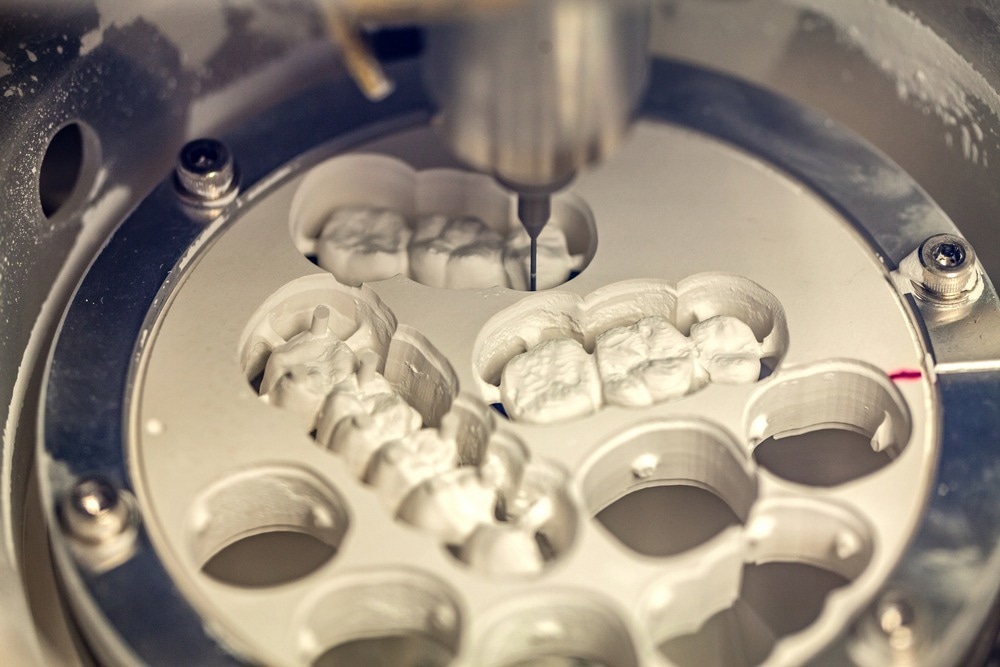In an article recently published in the journal Journal of the European Ceramic Societyresearchers discussed the development of three-dimensionally (3D) printed fully dense zirconia ceramics by extrusion for dental restorations.
Study: Extrusion-based 3D printing of fully dense zirconia ceramics for dental restorations. Image credit: Bencemor/Shutterstock.com
Record
Due to their characteristic properties, zirconia ceramics have attracted increasing interest for biomedical applications. Zirconia is difficult to fabricate into a 3D structure with complex geometry due to its extremely high chemical inertness and melting temperature. Computer-aided subtractive manufacturing (sCAM) has become the primary method for creating zirconia crowns and bridges in the dental field. Although this method is well known and offers many advantages, it also has some disadvantages.
A viable alternative to the limitations of sCAM technology is 3D printing (3DP). Dental ceramics can be produced using a variety of 3DP processes. The extrusion-based 3DP technique is considered to be the simplest and most economical of these technologies. Initial research has yielded encouraging findings of comparable robustness and accuracy. However, there are significant problems with this method that prohibit its acceptance in dentistry. To keep the overhang from collapsing, the system usually needs a support strategy. Support materials must also be easily removed without contaminating the structural elements.
About the Study
In this study, the authors discussed the fabrication of detailed, fully dense ceramics based on gelled zirconia suspensions and an improved extrusion-based 3D printing technique was created. The viscoelastic characteristics of the suspensions were adjusted to provide self-supporting characteristics and smooth flow through a 150-250 micron nozzle at a high solid volume fraction of 52%. The dried zirconia samples could be sintered directly without the need to remove the binder due to the low organic content.
The team showed that the flexural strength, maximum relative density and hardness of the sintered zirconia ceramic were 1010 MPa, 99.3% and 15.9 GPa, respectively. By co-printing a unique polyacrylic support material that could be removed by cooling due to its temperature-dependent rheological behavior, dental zirconia restorations were created while maintaining occlusal characteristics. An improved extrusion-based 3DP ceramic technique was created to develop flawless, fully functional ceramics suitable for dental restorations.
The researchers showed that to achieve self-supporting properties, aqueous suspensions for 3DP, in which ZrO2 functioned as a ceramic phase, were designed with low organic binder content and high solids loading. In addition, a brand new freeze-removable suspension-based polyacrylic (PAA) gelled support material system was created. Both the rheological characteristics of the suspensions and ZrO2 The suitability of the suspension for 3D printing was examined. The mechanical properties of the sintered samples under various sintering conditions were characterized after the green bodies of the samples were fabricated. Dental crown and tooth samples were taken to confirm the viability of the procedure.
Observations
For the correct production of delicate parts with protrusions, the support was one of the most critical parts. Based on a gelled PAA suspension, a new freeze-removable support system was created. This suspension exhibited temperature-dependent rheological characteristics and served as a supporting substance in this process. Thus, the cooling facilitated the removal of the support.
Both zirconia and PAA posts could be 3D printed without difficulty using the proposed technique. Due to the extremely low organic binder fraction, the dried zirconia samples could be sintered without the need for binder removal processes. The sintered zirconia samples had a flexural strength of 1010 MPa, maximum relative densities of 99.3% and hardness of 15.9 GPa. The information showed that the proposed method could create ceramics made of completely thick ZrO2.
In addition, dental crowns with color gradient and translucency could be produced without time-consuming post-processing if the correct ZrO2 Suspensions with different pigments or transparency modifiers were synthesized and mixed prior to extrusion. However, the milling method continued to be superior to this extrusion-based 3DP ceramic technology. Printing was extremely slow and the surface roughness was unacceptable.
conclusions
In conclusion, this study clarified the development of an optimized extrusion-based 3DP technique for gelled zirconia suspensions. The viscoelastic characteristics of the suspension were adjusted to form self-supporting characteristics and allowed flow through a 0.15-0.25 mm nozzle at a high solid volume percentage. The ZrO2 The suspension was extruded using an eccentric screw distributor that was extremely accurate. To show how the proposed approach could produce dental restorations with complex geometry when used with the PAA support, ZrO2 tooth and dental crown fabrication was performed.
The authors reported that the aforementioned features provided good process accuracy for the creation of complex ceramic structures. They also stated that a new path has been opened to fabricate flawless, fully dense dental restorations with relatively high precision thanks to the special formulations of gelled ZrO2 and PAA inhibitions and the insight provided by the effects of facility and parameters on process accuracy.
The team believes that it is necessary to continue researching optimization techniques to increase production accuracy and efficiency.
More from AZoM: How are bioplastics made?
bibliographical references
Jiaxiao, S., Xie, B., Zicai, Z., Extrusion-based 3D printing of full-density zirconia ceramics for dental restorations. Journal of the European Ceramic Society (2022). https://www.sciencedirect.com/science/article/abs/pii/S095522192200855X



